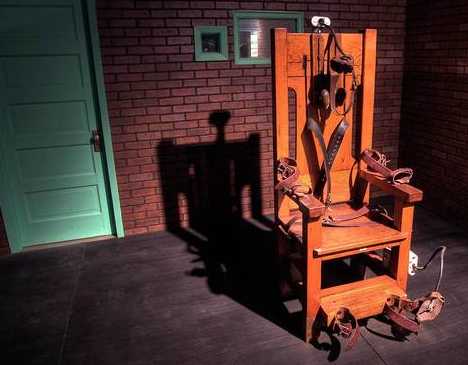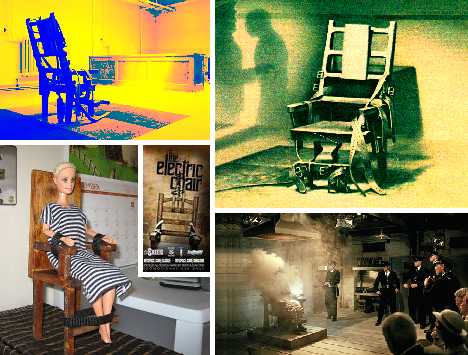
Are you sitting comfortably? Good… so was Giuseppe Zangara, 78 years ago today, when authorities at the Florida State Penitentiary flipped the switch on “Old Sparky” and sent the prisoner sic transit electric into the great beyond. This look at execution by electrocution focuses on Old Sparky – the electric chair employed exclusively by the United States and its dependencies from 1890 through 2010.
“Push the Button!”
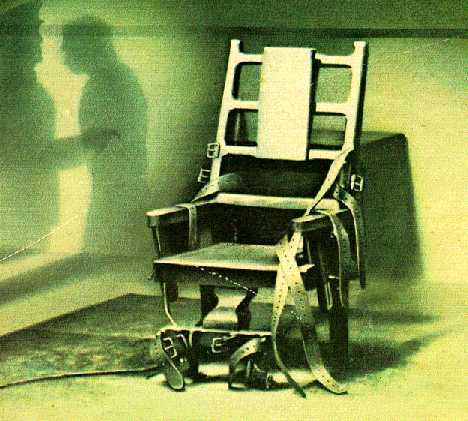 (image via: Gangs Or Us)
(image via: Gangs Or Us)
On February 15, 1933, Italian immigrant Giuseppe Zangara attempted to assassinate U.S. President Franklin Delano Roosevelt using a .32-caliber pistol. Zangara missed FDR but his wild firing hit 5 others, including Chicago mayor Anton Cermak who died of his wounds on March 6.
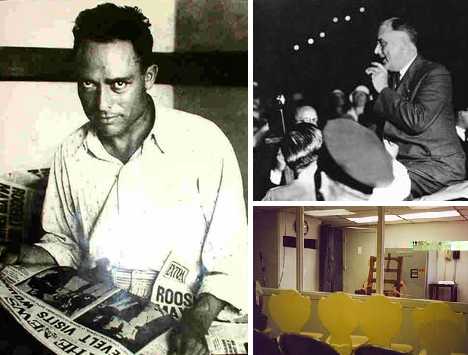 (images via: Find A Grave and Why Y Radio)
(images via: Find A Grave and Why Y Radio)
Tried and convicted of first-degree murder, Zangara (above, left) was sentenced to death in Florida’s “Old Sparky” electric chair – a sentence that was carried out a mere two weeks later, on March 20. Angry and defiant to the end, Zangara’s final statement before being executed was “Viva Italia! Goodbye to all poor peoples everywhere! Push the button!”
Spark of Genius?
 (images via: Analytical Synthesis, Reformation.org and P.A.P.-Blog)
(images via: Analytical Synthesis, Reformation.org and P.A.P.-Blog)
By the time Zangara was zapped, the Electric Chair had been a proven method of execution in the United States for decades. Its first use was on convicted murder William Kemmler, at New York state’s Auburn Prison (below) on August 6, 1890. The first woman to be executed via electrocution was Martha M. Place. Convicted of murdering her step-daughter, Place was executed at Sing Sing Prison in New York State exactly 34 years before Zangara: on March 20, 1899.
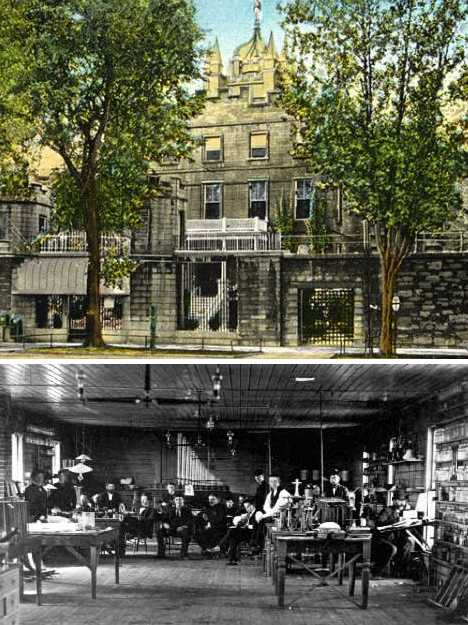 (images via: Geocaching and DC2NET)
(images via: Geocaching and DC2NET)
Both of the aforementioned executions occurred in the state of New York. Coincidence? Not at all – the Empire State pioneered the use of execution by electrocution after a committee was set up to determine a more humane method (compared to hanging) of carrying out death sentences. It was also no coincidence that Thomas Alva Edison, the inventor of the light bulb, is associated with the development of the electric chair.
 (images via: Tesla: The Lost Wizard and Etherealisation)
(images via: Tesla: The Lost Wizard and Etherealisation)
The Wizard of Menlo Park did not design the original electric chair, but the two men who did (Harold P. Brown and Arthur Kennelly) were both employees of Edison and the latter zealously promoted their work as part of his preference for DC current in the famous War of the Currents with Nikola Tesla & George Westinghouse, and an AC-powered electric chair would seem to suit Edison’s purposes perfectly. To that end, a number of experiments to test and refine the apparatus (including electrocuting an elephant) were conducted in 1888 at Edison’s laboratory in West Orange, New Jersey. By 1889, the electric chair was deemed both safe (for the operators) and effective, and the state committee approved it for use. Old Sparky wouldn’t have to wait too long to entertain its first “guest”.
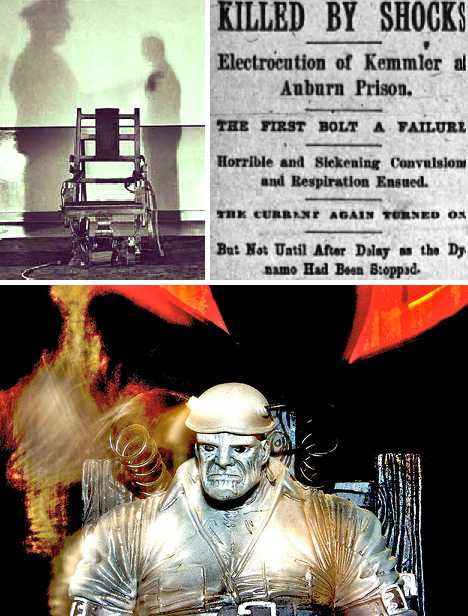 (images via: TruTV, Footnote and A History Of Drinking)
(images via: TruTV, Footnote and A History Of Drinking)
The state committee may have given the electric chair their stamp of approval but witnesses at Kemmler’s execution, not so much. The initial 17-second charge merely knocked Kemmler unconscious, prompting attending physician E.C. Spitzka to shout “Have the current turned on again, quick, no delay!” Not only was the current turned on again, the power was amped up to 2,000 volts. Kemmler’s body caught fire in what one reporter called “an awful spectacle, far worse than hanging”. George Westinghouse commented later that “they would have done better using an axe.”
Chair and Chair Alike
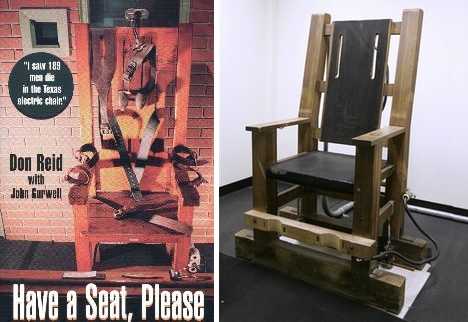 (images via: Asergeev, Death Penalty In Texas and Canadian Content)
(images via: Asergeev, Death Penalty In Texas and Canadian Content)
Sensationalistic reports notwithstanding, prisons in as many as 26 states (plus D.C.) were quick to adopt the electric chair as their preferred – and in some cases, only – method of execution. In Kentucky the electric chair was first used in 1911; in Texas it first came on line in 1924. Georgia’s electric chair was installed at Reidsville State Prison in 1924 and the original, white-painted chair was in use through 1980.
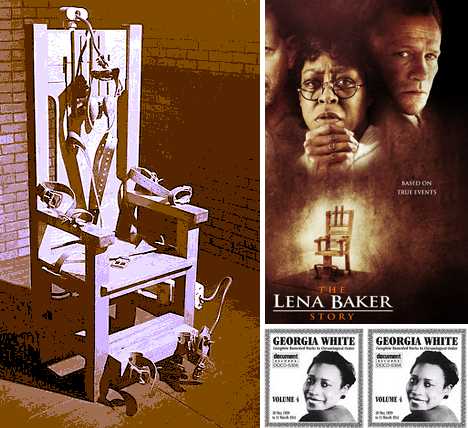 (images via: Georgia Info, American World Pictures and The Mix)
(images via: Georgia Info, American World Pictures and The Mix)
Georgia may have replaced their white electric chair with a clear-varnished model but the switchover didn’t disrupt the state’s execution agenda: a total of 441 prisoners rode the lightning between 1924 and 1998 including Lena Baker, the first Georgia woman to be sent to the electric chair. Lethal injection was instituted as the primary method of execution in October of 2001 but Georgia’s Old Sparky waits in the wings – literally: the chair is stored in a side closet outside the execution chamber at the Georgia Diagnostic and Classification Center… just in case.
Electric Ladyland
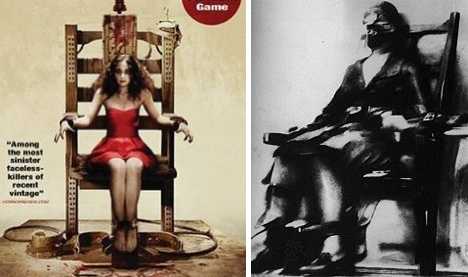 (images via: Last Movie Review On The Left and Executed Today)
(images via: Last Movie Review On The Left and Executed Today)
Speaking of Lena Baker, sending women to the electric chair wasn’t as rare as one might think – nor, at least according to the judges and juries of the day, was it cruel or unusual. We mentioned Martha M. Place, who met her maker exactly 112 years ago on March 20 of 1899. Lynda Lyon Block was the most recent woman to be executed by electrocution, on May 10 of 2002 in Alabama. One especially notorious case was that of Ruth Snyder, convicted of murder and executed on January 12, 1928, in the electric chair at New York’s Sing Sing prison. At the moment the switch was flipped, a reporter activated a hidden camera strapped to his leg – the photo of the about-to-be-late Mrs. Snyder (shown above, right) was subsequently splashed across the front page of the next day’s New York Daily News.
The Original Buzzkill
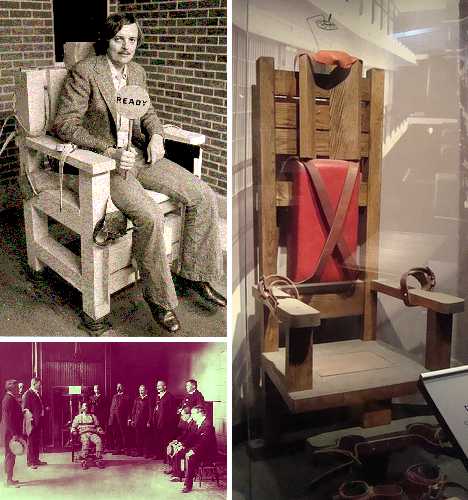 (images via: Bob Lowry’s UPI-Related Images, I Zimbra and Treehugger)
(images via: Bob Lowry’s UPI-Related Images, I Zimbra and Treehugger)
Though most electric chairs were nicknamed Old Sparky, a few carried their own unique colloquial designations. Louisiana’s electric chair, which in 1940 replaced hanging as the primary method of execution in the state, was dubbed Gruesome Gertie. Indiana’s chair was Old Betsy and Alabama’s (above, left) was called Yellow Mama. Pennsylvania, New Jersey and Tennessee were partial to Old Smokey (above, right), though those states’ death row denizens undoubtedly did not share the feeling.
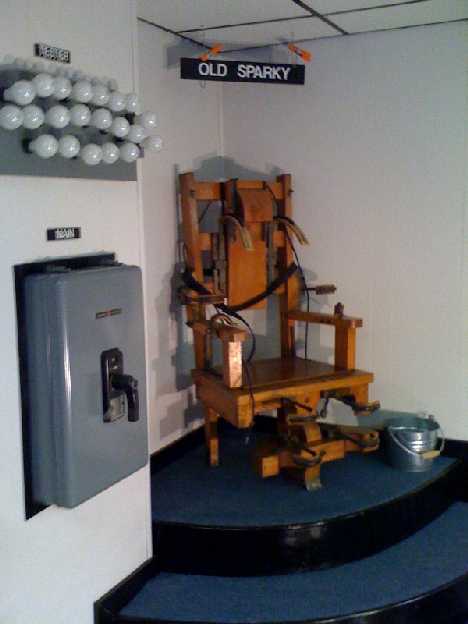 (image via: The Little Cat Blog)
(image via: The Little Cat Blog)
West Virginia’s version of Old Sparky was used at the closed-in-1995 West Virginia State Penitentiary in Moundsville between 1950 and 1959. The chair was activated by three designated executioners who would each press a button simultaneously. As only one of the buttons was connected to the circuit, each of the button-pressers was left with a reasonable doubt that they were the actual executioner.
America Sockets to ‘Em
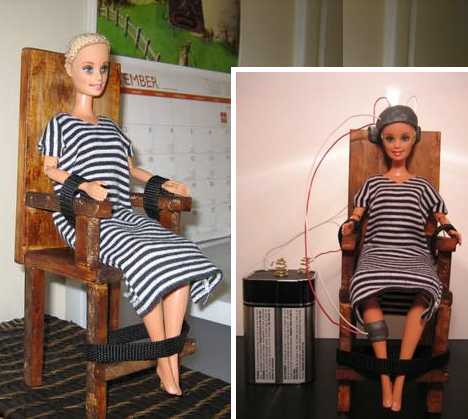 (images via: Gizmodo and BoingBoing)
(images via: Gizmodo and BoingBoing)
The electric chair was an American invention and has been an American institution for well over a hundred years. One would think an innovation used for so long would be taken up by other nations, yet that has not been the case. In fact, only the Philippines – formerly an American possession – employed a version of Old Sparky to conduct executions between 1926 and 1976. We’re not sure why… hey, the Chair’s good enough for Barbie!
 (images via: Executed Today, Divisoria and Video48)
(images via: Executed Today, Divisoria and Video48)
The Philippines under dictator Ferdinand Marcos took the concept of Old Sparky and ran with it: one day in May of 1972 (possibly a Fri-day?), a triple electrocution took place. Jaime Jose, Basilio Pineda and Edgardo Aquino were electrocuted side-by-side as punishment for the notorious 1967 kidnapping and gang-rape of popular actress Maggie dela Riva. It would be nice if we could state use of the electric chair was phased out by the Philippines in favor of a more humane alternative, but we can’t: post-1976 executions were by firing squad.
“Current” Events
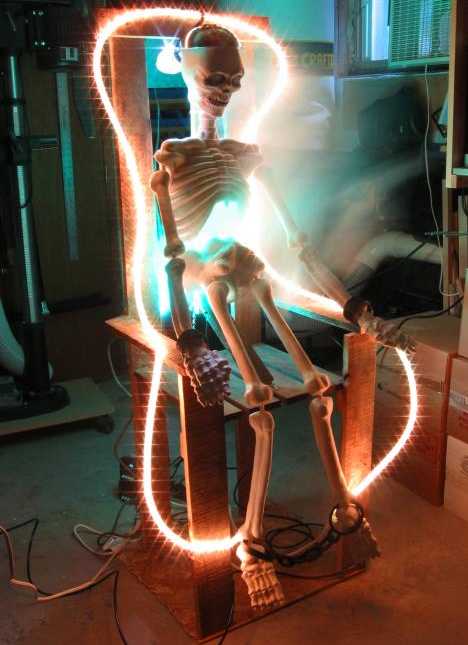 (image via: Chair Blog)
(image via: Chair Blog)
Is it time to finally pull the plug on Old Sparky? Indeed, the electric chair’s long reign appears to be slowly and surely flickering to a close. Electrocution is listed as an optional form of execution in Alabama, Florida, South Carolina and Virginia as of 2010, and in Arkansas, Illinois, and Oklahoma the electric chair is officially an alternate form of execution, only to be approved for use “if other forms of execution are found unconstitutional in the state at the time of execution.”
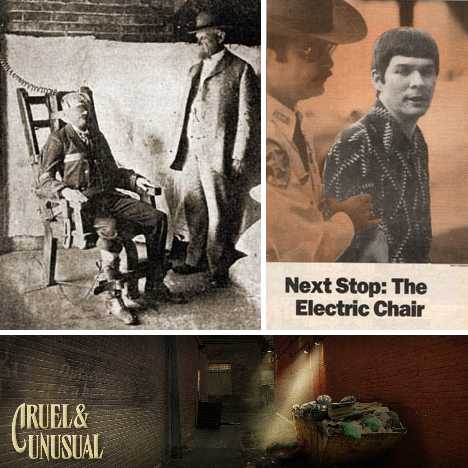 (images via: Facebook, Baltimore City Paper and Patricia Cornwell)
(images via: Facebook, Baltimore City Paper and Patricia Cornwell)
The most recent instance of a prisoner executed via electrocution is the case of Paul Warner Powell, who was executed in Virginia on March 18, 2010, after he chose Old Sparky in preference of the alternative: lethal injection.
 (images via: Factoidz, Filmous, Fantastic Fiction and Ads Of The World)
(images via: Factoidz, Filmous, Fantastic Fiction and Ads Of The World)
Ironically, electrocution is being supplanted by lethal injection for the same reason the electric chair replaced hanging: it is considered to be a more humane method of executing those legally condemned to death. Maybe those comparing Old Sparky and “Old Squirty” were influenced by a long list of grisly botched electrocutions (five since 1993 alone) that included that of Allen Lee “Tiny” Davis in 1999. It’s likely Stephen King, author of The Green Mile, was influenced by lurid reports of these execution errors.
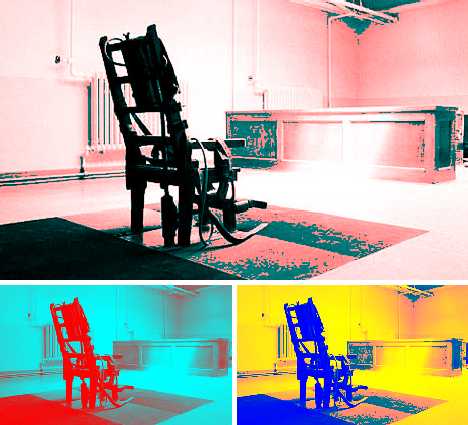 (image via: Guardian UK)
(image via: Guardian UK)
Leaked photographs of Davis slumped in the electric chair, his shirt red with blood, incited protests and legal challenges that sought to depict use of the electric chair as cruel and unusual punishment. Considering authorities have had nearly a century to get it right and still haven’t succeeded, the depiction may have merit. Maybe it’s time for a switch… wait, not that switch!!
